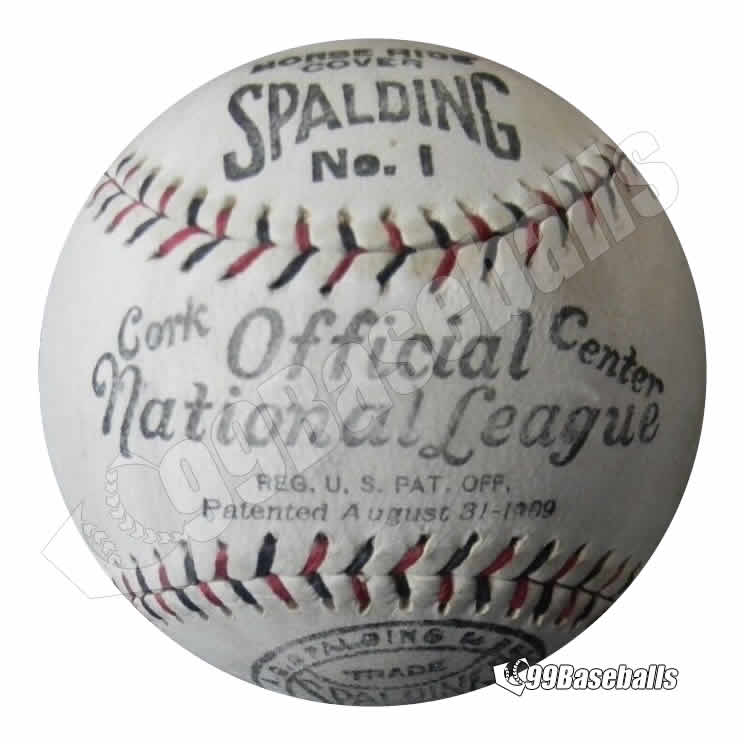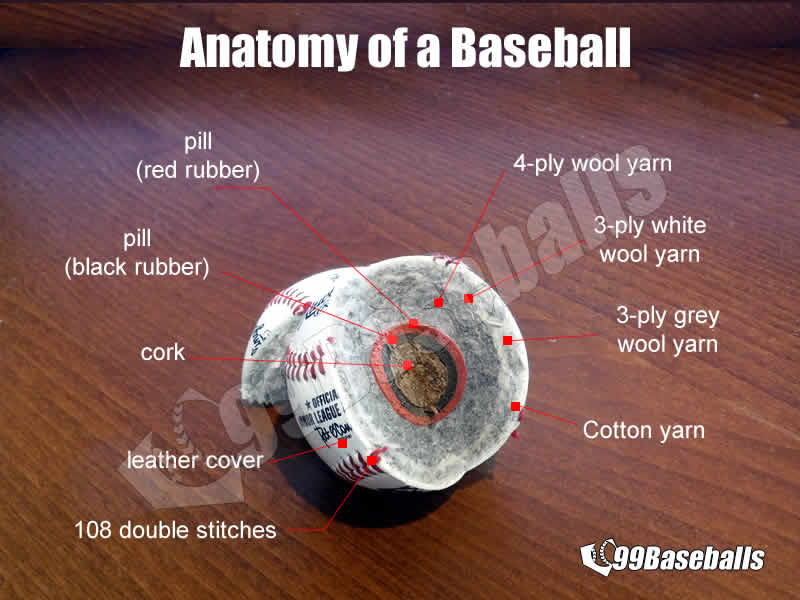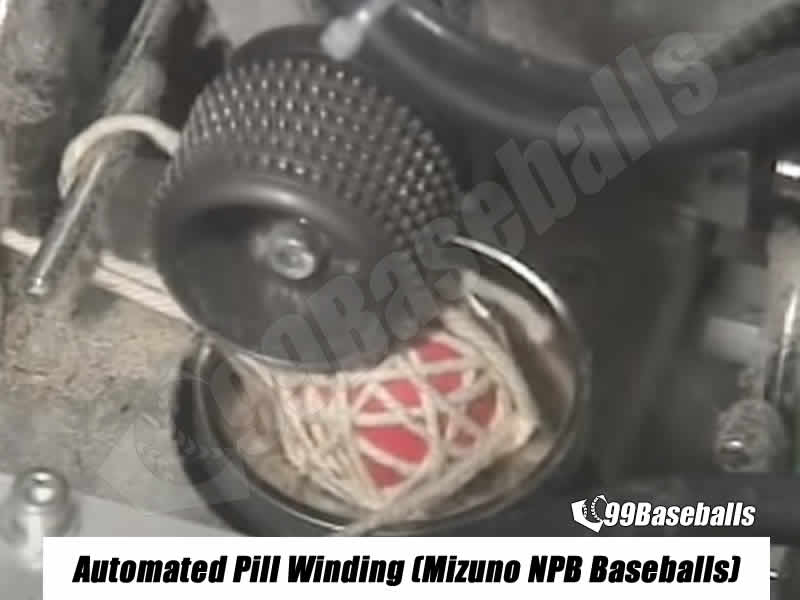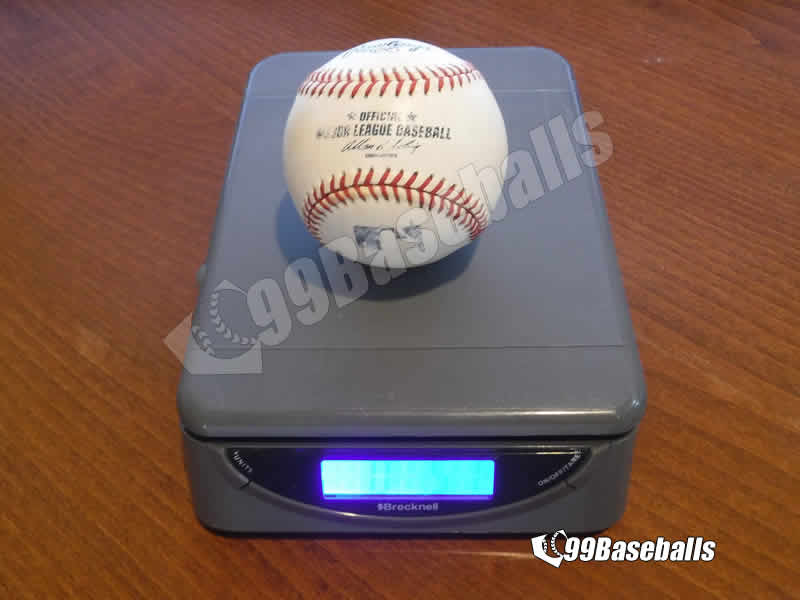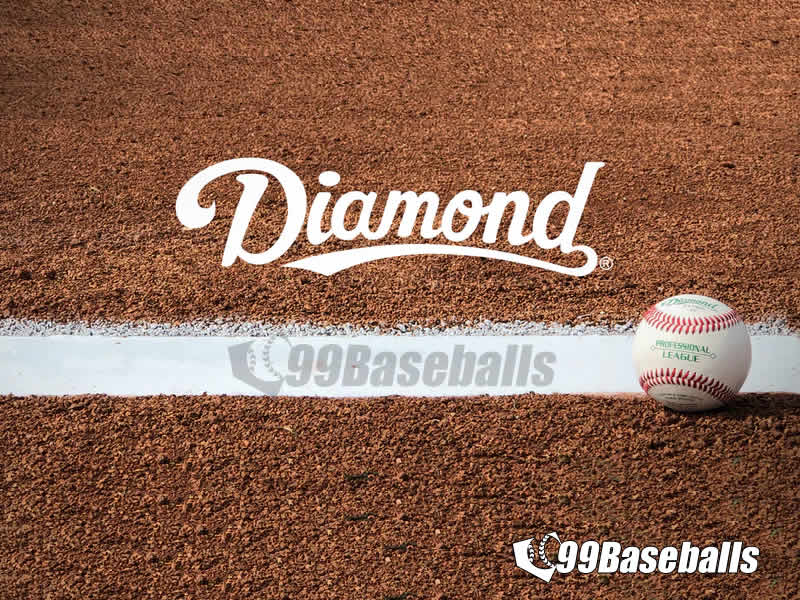Ever wondered how much a baseball weighs? A ball used in a game of baseball is a crucial part of the game, impacting everything from how it’s played to how players hone their batting and catching skills.
According to the current 2024 MLB rules, a baseball’s weight ranges between 5 and 5 ¼ ounces avoirdupois (that’s about 142 to 149 grams, if you’re wondering).

The exact weight can vary slightly based on the type of baseball, who’s playing (like different age groups), league affiliations, and even who made the ball.
The historical manipulation of baseballs, including the weight of a baseball, serves as a fascinating chapter in the baseball’s history, highlighting the importance of this seemingly small factor in the dynamics of the game.
As a youth coach and a lifelong fan of baseball, researching and understanding the weight of a baseball gave me a deeper appreciation of the sport and I hope that it will do the same for you. So, let’s dive in and explore how the weight of a baseball has shifted over the years, shall we?
Table of Contents
- Baseball Specifications – Size and Weight
- Why is the weight of a baseball so important?
- How the Weight of a Baseball has Changed
- The Official Weight of a Baseball Today
- Evolution of Materials Used Make Baseballs
- Mass of a Baseball – Components and Weight
- Do All Baseballs Weigh the Same?
- Which Baseball will Travel Farther? A heavier baseball or a lighter baseball?
- Weighing Baseballs
- Is the Baseball Too Heavy or Too Light?
- Takeaways
- Frequently Asked Questions
- You May Also Like
Baseball Specifications – Size and Weight
Modern baseball evolved from the English game of “rounders” in the first half of the 19th century.
In 1845, Alexander Cartwright of New York formulated the basic rules of baseball, which called for the replacement of the soft ball used in rounders with a smaller hard ball.
Believe it or not, the original Official Baseball Rule 1.09 prescribing how baseballs should be made is still in use today in MLB!
MLB Rules 1.09 – The Ball should be a sphere formed by yarn wound around a small sphere of cork, rubber, or similar material covered with two stripes of white horsehide or cowhide, tightly stitched together. It shall weight not less than 5 nor more than 5 1/4 ounces avoirdupuois and measure no less than 9 or more than 9 1/4 inches in circumference.
The cork nucleus, enclosed in rubber, is wound with 121 yards of blue-gray wool yarn, 45 yards of white wool yarn, and 150 yards of fine cotton yarn. Core and winding are enclosed by rubber cement and a two piece cowhide (horsehide before 1974) cover hand-stitched together with just 216 raised red cotton (single) stitches or 108 double stitches.
Why is the weight of a baseball so important?
For the uninitiated, all baseballs may look the same with red stiches on pearly white leather covers, and don’t think too much about the weight of a baseball.
Officially, the current 2024 Major League Baseball (MLB) specifications calls for an MLB baseball to weigh between 5 to 5 1/4 ounces to ensure performance consistency and fairness.
Lacrosse ball is a synthetic, rubber ball manufactured with tighter variance specs than baseballs. Since all Lacrosse balls weigh exactly 5 ounces or 145 grams, it is an excellent point of reference when comparing the weight of various baseballs.
However, the weight of the baseball hasn’t always been this standardized, and its historical manipulation has led to some intriguing game strategies.
Pitching Performance and Batting Considerations
The weight of the baseball significantly impacts pitching performance as it determines the effort a pitcher must exert to throw the ball.
How much force is placed on a pitchers elbow? According to the The American Journal of Sports Medicine (AJSM), the biomechanics of the baseball throw places a force on the Ulnar Collateral Ligament (UCL) of pitcher's elbow reaching 64Nm (nearly 50lbs)!
Additionally, the weight influences the movement of pitches, with heavier baseballs potentially having less “break” than lighter ones, affecting the pitcher’s ability to deceive hitters with curveballs or sliders.
Heavier balls require more force, which can increase strain on the pitcher’s arm. On the contrary, a ball that’s too light may lead to less accuracy due to control difficulties.
From the hitter’s standpoint, heavier balls will be more challenging to hit long distances, requiring better timing and increased power. In contrast, lighter balls might be easier to hit but may not travel as far, leading to more groundballs or flyouts.
Historical Manipulation of Baseballs
Historically, before the standardization of baseball weight and construction, teams would often manipulate baseballs to gain an advantage. This practice is commonly referred to as “doctoring” the baseballs.
Clubhouse attendants were known to rub baseballs in various substances, ranging from tobacco juice to mud, to make them more difficult for hitters to see and hit. This was done to favor the home team’s pitchers. In other cases, teams would alter the weight of the baseballs which were thought to be harder to hit out of the park, thus favoring pitchers.
One famous case involves the 1905 New York Giants under the management of John McGraw. Many sportswriters at the time suspected that McGraw had ordered the balls to be frozen, making them denser (and therefore heavier), which was advantageous for his standout pitching staff, including Hall of Famer Christy Mathewson.
Many of these doctoring tactics were eventually outlawed as the leagues moved toward standardization to ensure a fair competition. Today, altering a baseball in any way during a game is strictly prohibited in professional baseball (but still happens periodically).
How the Weight of a Baseball has Changed
Baseball in its primitive form can be traced back to the early 19th century. At that time, baseballs were often handmade and lacked the uniformity we see in today’s manufactured balls.
The weight and size of these baseballs varied widely depending on the individual making the ball and the materials available to them. Baseball weight variability posed challenges to fair play and competitive balance, underlining the need for standardization.
| What is Avoirdupois? |
|---|
The term “avoirdupois” is a French word, describing the avoirdupois weight system, which is a system of weights (or mass) based on a pound of 16 ounces. It’s the system predominantly used in the United States and is applied across various fields to measure weight. In the context of Major League Baseball (MLB), when they specify the weight of the baseball as “not less than five nor more than 5 ¼ ounces avoirdupois,” they’re using this system to define the acceptable weight range for baseballs used in official games. This specification ensures consistency in the size and weight of the baseballs, which, in turn, affects how the game is played, including pitching speeds and hitting dynamics. |
By the late 19th century, the need for standardization was keenly felt, and various leagues began to explore an optimum weight that would strike a balance between gameplay, competitiveness, and safety (please note that vintage baseballs were much heavier than current baseballs):
- 1857 – Code of Rules for the government of the game of base ball adopted a rule stipulating that the baseball should “weigh not less than six no more than six and one-quarter ounces avoirdupois”
- 1859 – National Association of (Amateur) Baseball Ball Players adopted the Section 1 baseball weight rule, “the ball must weigh not less than five-and-three-fourths, nor more than six ounces avoirdupois” (between 5.75 ounces and 6 ounces)
- 1865 – National Association of (Amateur) Baseball Ball Players revised Section1 (official baseball weight rule) to state “the ball must weigh not less than five and one-half, nor more than five and three-fourths ounces” (between 5.5 and 5.75 ounces)
- 1868 – National Association of (Amateur) Baseball Ball Players revised Section 1 baseball weight rule to the current standard, “the ball must weigh not less than five ounces, nor more than five and one-quarter ounces, avoirdupois” (between 5 and 5.25 ounces)
- 1871 – the National Association of Professional Base Ball Players is formed and re-affirms the same baseball weight requirement from 1968
- 1876 – Chicago businessman, William Hulbert, formed the National League of Professional Baseball Clubs to replace the National Association of Professional Base Ball Players; keeps the same baseball weight requirement
The precursor to the MLB, the National League was created in 1876 by William Hulbert to replace the National Association of Professional Base Ball Players. It established a revised set of baseball rules but kept the baseball weight standards in order to maintain uniformity in the game’s competitive aspects.
The Official Weight of a Baseball Today
Today, the weight of MLB baseballs is tightly controlled, ensuring consistency and fairness in the game.
| MLB Rule 3.01 – The Ball (2021) |
|---|
| As of 2021, the MLB Rule 3.01 states that the ball shall be a sphere formed by yarn wound around a small core of cork, rubber or similar material, covered with two strips of white horsehide or cowhide, tightly stitched together. It shall weigh not less than five nor more than 5¼ ounces avoirdupois and measure not less than nine nor more than 9¼ inches in circumference. |
With few exceptions (which I will go over in detail), all baseballs from Little League to College use the MLB ball specifications in terms of size and weight.
Evolution of Materials Used Make Baseballs
The current physical standard for an official MLB baseball is 5 to 5.25 ounces in weight (around 142 to 149 grams), and have a circumference between 9 and 9.25 inches.
But the physical size and weight of a baseball are not the only factors that must be considered when trying to set a standard to create fair play.
Prior to 1920, when Spalding was selected as the Official National League baseball, balls were constructed with diverse materials which impacted both pitching and batting performances (remember that the American League (AL) or Major League baseball (MLB) was not established until later).
So let’s take a look at some of the materials used in the earlier days and how they impacted the game of baseball over the last 150+ years (if you want to read a really detailed info on this topic, read Baseball Ball – Evolution of the Iconic Sphere or History of Baseball – A Timeline of Notable Events)
Early Baseballs: Pre-1860s
In the early years of baseball, the balls were often handmade. Often, individuals used what they had on hand to create these balls. A core made from scrap rubber materials was wrapped in yarn or string and then covered in horsehide leather.

These baseballs lacked uniformity and their size, weight, and bounce varied significantly. Stitching was often crude and inconsistent. The very first baseballs used in the 1840s had a “lemon peel” stitch pattern, a design with four sections stitched together using exterior seam welds, quite different from the figure-eight pattern we’re accustomed to today.
The Dead Ball Era: 1900-1920
By the dawn of the 20th century, the handmade era began to fade as factories started to produce baseballs. This period, known as the “Dead Ball Era,” saw balls made with a rubber core wrapped in yarn and encased in a leather cover.

The balls were softer and less tightly wound, which resulted in fewer home runs.
Introduction of Cork Center: 1910
In 1910, a crucial change was made to the baseball’s design. The Spalding Company introduced a cork center in place of rubber.
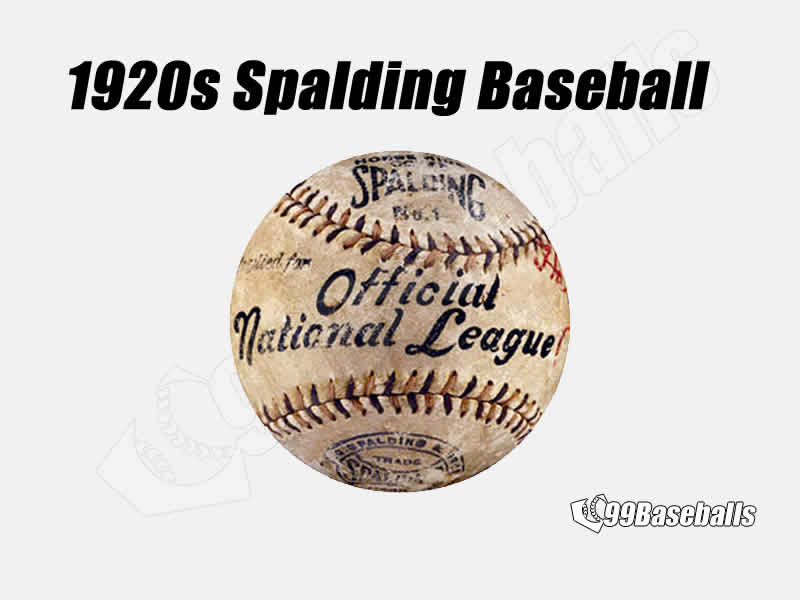
The cork was lighter and allowed for a tighter wind of the yarn, resulting in a firmer ball. This adjustment led to what many refer to as the “lively ball” era, where home runs became more common.
The Modern Baseball: Post-1970s
After several decades of minor changes, Rawlings became the official manufacturer of MLB baseballs in 1977.

The baseballs now featured a cushioned cork center, wound with nearly a mile of wool and poly/cotton yarn, and covered with premium cowhide leather, stitched together with precisely 108 double stitches.
21st Century Adjustments
In the 21st century, the composition of the baseball remained consistent, but controversy arose over subtle changes in construction that affected gameplay.

For example, a controversy arose in the mid-2010s about whether a purported “juiced ball” was causing a surge in home runs. In 2020, MLB confirmed minor alterations to the ball’s construction, though it maintained that the changes were within their standard production variations.
Mass of a Baseball – Components and Weight
There are many types of baseballs made for specific leagues or age of players for safety reasons but almost all “official”, game-ready baseballs have the same weight and size specs as that of an MLB/MiLB baseball (9 to 9.25 inches in circumference and 5 to 5.25 ounces in weight).

Manufacturers a combinations of materials to increase the safety of a ball but stay within the official league baseball specifications.
To keep in simple, let’s first take a look at what is inside a professional baseball. The picture below is a new MILB ball that was dissected to show the following parts (this particular ball weighed 5.1 ounces or 145 grams):
- 108 double stitches
- Two, leather covers
- Four layers of yarn windings
- Pill consisting of two layers of rubber plus a cork ball
Weight of Leather Covers and Red Baseball Stitches
Combined weight of two pieces of full-grain leather covers and baseball stitches weighed 10 ounces or 15 grams.
That means leather covers and red baseball stitches take up 10% of the total weight of a baseball.
Weight of Yarn Windings
Combined weight of all wool and cotton layers weighed 3.88 ounces or 110 grams.
Thus, the combined weight of yarns take up 76% of the total weight of a baseball.
Weight of a Pill

The combined layers or red and black rubber layers and cork together weighed 0.705 ounces or 20 grams:
- The red rubber weighed 0.35 ounces or 10 grams
- The black rubber weighed 0.178 ounces or 5 grams
- The cork ball weighed 0.178 ounces or 5 grams each
So a pill found in an MiLB baseball takes up 14% of the total weight of a baseball.
** Please note that minute rounding errors are included in the measurement.
Excluding are the few brands of tee balls that are made specifically for pre-kindergarten and kindergarten aged players. These baseballs have non-conforming sizes and weights (pre-K and K baseballs are smaller and lighter) so they are not classified as “official league” baseballs.
Do All Baseballs Weigh the Same?
The short answer is maybe.
But before going further, I highly suggest reading the post, different types of baseballs to understand how baseballs are made and specific types of baseballs that are commonly used each age group.
Automated Manufacturing Process
Over the years, machines have gradually taken over large part of the baseball manufacturing process so the weight variations between baseballs for a specific baseball brand and model is minimal.
For example, the Mizuno (What is the difference between MLB ball and Japanese ball?) has eliminated 90% of the manual processes by automating pill wrapping, glue application, yarn winding and other steps with an automated machines which greatly reduces the variations between each ball (stitching is still done by hand).
Rawlings, which makes MLB game baseballs, still uses a some craftsmen and machines to produce baseballs but steps found in YouTube video have largely been replaced by automated processes, though like Mizuno, baseball covers are still hand-stitched (ROMLB baseballs are hand-stitched in Costa Rica; MiLB and other league baseballs are hand-stitched in China).
How Humidity Affects Baseball Weight
Humidity is also a large factor in weight variation during the manufacturing process.
SSK makes awesome baseballs for all non-Nippon Professional Baseball (NPB) leagues like high school and others. Because SSK’s baseball manufacturing plant is located in Sri Lank (a region with high humidity), the plant tightly controls the temperature and humidity and their baseballs are double wrapped (shrink wrapped then in a UV stabilized, sealed bag).

How Water or Rain Affects Baseball Weight
Most baseballs are made with natural leather and have seams and holes for water to penetrate, and the yarn inside can rapidly absorb water.
So playing in rain can pose a significant challenge, if not impossible task, to ensure that the weight of a baseball do not change (we used to rotate 10 balls and have towels ready).

Situation is a bit better if you are using a synthetic cover ball or youth baseballs with solid foam core because they provide limited water resistance.
If you are thinking about buying used baseballs, you will want to bring a digital scale to verify the weight of baseballs.
Regardless of which types of baseball you use, keeping baseballs in a bucket with a lid, along with some desiccant packs.
Which Baseball will Travel Farther? A heavier baseball or a lighter baseball?
There’s a balance when it comes to the weight of a baseball and how far it can travel when hit. The physics principle at play here is Newton’s Second Law of Motion, f=ma.
This law states that the force applied to an object is equal to the mass of the object multiplied by its acceleration.
So, according to Newton, a lighter baseball will accelerate more quickly when hit because it has less mass, which might suggest it could travel farther. However, it’s also more susceptible to air resistance or drag, which will slow it down more quickly.
On the other hand, a heavier baseball is harder to get moving (requires more force), but once it’s in motion, it’s less affected by air resistance due to its momentum. However, it’s worth noting that a heavier ball may also be more difficult for the batter to hit with the same speed as a lighter ball, which could potentially offset this advantage.
Please note that the ultimate distance a baseball will travel depends on more than just its weight. Factors such as the angle and speed of the pitch, the speed and angle of the bat, the spin of the ball, and even the atmospheric conditions can significantly affect how far a baseball will travel when hit.
Weighing Baseballs
I have over 3,000 new and used baseballs that I have collected over the years (they are not the collectible balls like Zack Hample’s collection) so I grabbed a few to see their weights.
I will add more baseballs in the near future, but if you have a baseball or two you would like to share, contact us.
Rawlings ROMLB baseballs
Rawlings MLB ROMLB baseball comes with a pill, yarn winding and leather covers. Most balls come with tight seams but the quality can be a hit-or-miss.
- Weight (new) : 5.0 ounces, 0.3125 pound, 140 grams, 0.140 Kg
- Weight (used): 5.2 ounces, 0.3250 pound, 145 grams, 0.145 Kg
Rawlings MiLB Minor League baseballs
Rawlings MiLB baseball comes with the same specs as ROMLB. MLB started experimenting with “stickier” leather covers for several minor league teams located in Arizon in 2023. Expect a change in weight.
- Weight (new) : 5.1 ounces, 0.3250 pound, 145 grams, 0.145 Kg
- Weight (used): 5.1 ounces, 0.3250 pound, 145 grams, 0.145 Kg
Diamond D-OB baseballs
Diamond D-OB baseball comes with a solid cork composition core (read my Reference Guide to All Diamond Baseballs for more info), so the weight variation is minimal at 2 ounces (about four, empty soda cans)
- Weight (new) : 5.1 ounces, 0.3188 pound, 144.583 grams, 0.145 Kg
- Weight (used): 5.2 ounces, 0.3250 pound, 147.418 grams, 0.147 Kg
MacGregor SEV Index Level 5 Baseballs
MacGregor SEV Index Level 5 baseball comes with a synthetic ball (Tri-Flex foam core made prior to 2020; 2021 and newer models come with a high density rubber core).

- Weight (new) : not available
- Weight (used) : 4.9 ounces, 0.3625 pound, 138.91 grams, 0.139 Kg
Mizuno Nippon Professional Baseball (NPB) baseballs
Mizuno NPB baseballs was muck talked about in 2020 Tokyo Olympics and highly rated by MLB players due to their “stickiness”. Like the ROMLB baseballs, each NPB ball are shrink wrapped to prevent moisture penetration.
- Weight (new) : 5.3 ounces, 0.3313 pound, 152 grams, 0.152 Kg
- Weight (used) : not available
Rawlings ROLB1 baseballs
Rawlings ROLB1 baseball is a competition grade baseball for 14U and under players. The primary purpose is for BP and practice.
- Weight (new) : 5.3 ounces, 0.3316 pound, 150 grams, 0.150 Kg
- Weight (used) : 5.2 ounces, 0.3250 pound, 145 grams, 0.145 Kg
SSK Grand Meister baseballs
SSK Grand Meister baseballs are high quality balls made in Sri Lanka for SSK. Intended for high school players, SSK baseballs come in high quality leather cover like Miuzno NPB baseballs.
- Weight (new) : 5.2 ounces, 0.3250 pound, 145 grams, 0.145 Kg
- Weight (used) : not available
Is the Baseball Too Heavy or Too Light?
If you are only familiar with metric system and have never held a baseball, five ounces is roughly equal to ten AA batteries or USA 25 quarters.
The permitted variation of 0.25 ounces is roughly equal to a playing card or three US pennies (post 1983) so it is really difficult to tell it apart.
On the other hand, a rain soaked baseball is easy to tell apart since the wet ball will weigh about 2 extra ounces (the weight of a tennis ball).
Either way, you will need a digital scale to accurately verify the weight of a baseball in question.
Takeaways
Since its implementation, this weight standard has remained relatively unaltered, a testament to the meticulous consideration that went into its formation.
Today, the weight of a baseball is just one of the tightly controlled specifications enforced by the MLB, including the ball’s circumference, the type and amount of yarn or string, and the quality of the leather cover. Each baseball used in professional play is rigorously checked to ensure it meets these stringent requirements.
| Please don’t forget to visit Buying Baseballs – Reference Articles page to read other fascinating information about baseballs! |
Frequently Asked Questions
While it may seem like a minor detail, the decision-making process behind the weight standard of a baseball is steeped in historical context and careful consideration, providing a fair and uniform playing field for its athletes.
Below is a list of some of the most frequently asked questions about the weight of a baseball.
What is the standardized weight of a baseball in Major League Baseball (MLB)?
The standardized weight of a baseball used in Major League Baseball (MLB) is between 5.00 ounces to 5.25 ounces, or approximately 131.75 to 148.83 grams.
How has the size and weight of baseballs changed since 1860?
The size and weight of baseballs have become standardized over time. In the early days of the sport, there was a significant variation in the size and weight of the balls. It wasn’t until 1872 that the weight was standardized to the current range. This standardization has helped maintain consistency in the game.
What are the main components of a baseball?
A baseball consists of a small core made of cork or rubber, which is then wrapped in yarn or string. This core and string assembly is covered in two figure-eight shaped pieces of cowhide leather, which are stitched together using red cotton thread.
How does the weight of the ball impact its performance in the game?
The weight of a baseball affects its flight and how it behaves when hit or thrown. Heavier balls are more difficult to hit long distances and are generally slower when thrown. Conversely, lighter balls can be thrown faster and hit further but may also be more difficult to control.
Why is there a need for standardization of baseball weight in professional leagues?
Standardization ensures that each game is fair and that no team gains an advantage due to the baseball’s size or weight. It also allows for consistency in player performance and statistics.
Has the weight of the baseball had an impact on the evolution of the game over the years?
Yes, changes in the weight and construction of the baseball over the years have led to shifts in the way the game is played. For instance, lighter balls tend to travel farther when hit, which could increase the number of home runs in the sport.
Can slight variations in baseball weight affect a player’s performance?
Yes, even slight changes can impact a player’s performance. For pitchers, a lighter ball can lead to increased pitch speed, while a heavier ball might lead to more control but less speed. Hitters might find it easier to hit home runs with a lighter ball.
What role does Rawlings play in ensuring the standardization of baseball weights?
As the official supplier of baseballs to the MLB, Rawlings plays a crucial role in maintaining the standardization of baseball weights. The company uses strict quality control measures to ensure that each baseball it manufactures falls within the specified size and weight ranges.
How are baseballs manufactured to maintain a consistent weight and size?
Baseballs are manufactured through a multi-step process, which includes forming the core, winding the yarn, and stitching the cowhide cover. During this process, precision machines and quality control measures are used to ensure consistency in size and weight.
What materials are used to create the inner and outer cores of a baseball?
The inner core of a baseball, often called the “pill,” is made of rubber and cork. The outer core consists of multiple layers of yarn or wool, wound tightly around the inner core.
How have changes in manufacturing techniques affected the consistency of baseball weight over time?
Improvements in manufacturing techniques and quality control have led to greater consistency in baseball weights and sizes over time. With the advent of precise machinery and standardized materials, the variation in weight between individual baseballs has decreased.
What is the weight of a baseball used in amateur leagues versus professional leagues?
In both amateur and professional leagues, the weight of a baseball is approximately the same – between 5.00 and 5.25 ounces. The main difference can be in the quality and consistency of the balls used.
What quality control measures are used to ensure each baseball meets weight and size specifications?
During manufacturing, each baseball is weighed and measured to ensure it falls within the specified weight and size ranges. Additionally, each ball is visually inspected for defects and must meet strict quality standards before being approved for use.
How can a baseball’s weight affect the pitcher’s throwing mechanics?
The weight of the baseball can influence the speed, control, and type of pitches a pitcher can throw. For instance, a heavier ball might be harder to throw fast, but could offer better control. Conversely, a lighter ball might be thrown faster but with less control.
Why was the specific weight standard chosen for baseballs in professional leagues?
The specific weight standard was chosen to balance the needs of both pitchers and batters. It is designed to ensure the ball is heavy enough to provide control for the pitcher, but light enough to allow for a full range of hitting possibilities.
Are there any differences in baseball weights used across different global baseball leagues?
Most baseball leagues worldwide adhere to the same weight standards set by the MLB, which range from 5.00 to 5.25 ounces. However, there may be slight variations in local or amateur leagues.
How has the design of baseballs changed over time to improve performance and safety?
The design of baseballs has evolved to balance performance and safety. For example, early baseballs were harder with less predictable flight paths, which could be dangerous. Modern baseballs have a cork and rubber core, wound with yarn, which gives them a more predictable bounce and flight path.
What’s the process for checking the weight of the baseballs before an MLB game?
Baseballs are checked for weight and size during the manufacturing process. Once they reach the ballpark, umpires will visually inspect the balls for any noticeable defects, but they typically do not weigh the balls.
What is the weight variance allowed for baseballs used in MLB?
The weight variance allowed for baseballs in the MLB is quite small, between 5.00 to 5.25 ounces. This narrow range ensures consistency in play.
How does the weight of a baseball contribute to its flight characteristics, such as speed, trajectory, and distance?
The weight of a baseball directly impacts its flight characteristics. A heavier ball will generally have a slower speed, shorter trajectory, and lesser distance. Conversely, a lighter ball can be thrown with a higher speed, and potentially have a higher trajectory and longer distance.

